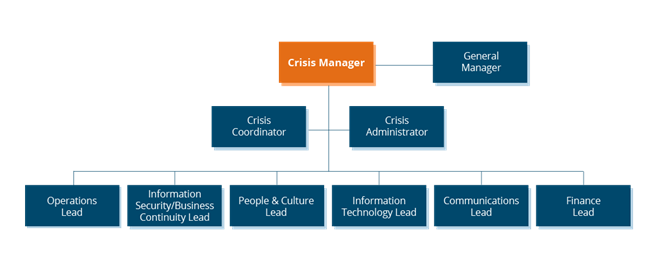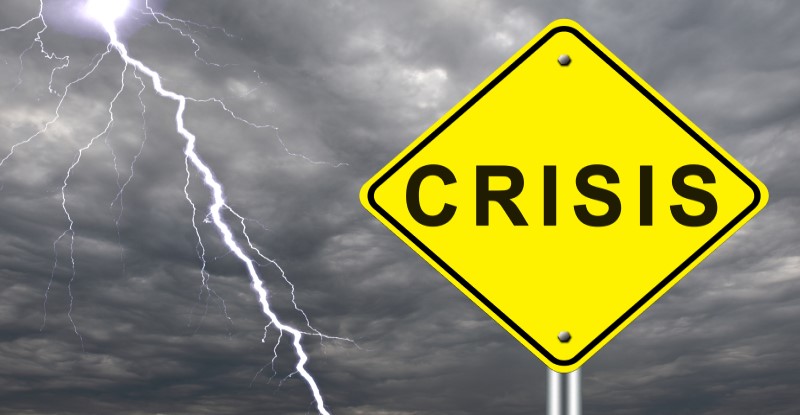
When a crisis strikes, business continuity and lives are at risk. Being prepared greatly increases your chance of survival.
A crisis management plan details what to do in the event of a natural disaster, terrorist threat, cyber-attack or other serious event. It helps you manage crises effectively by identifying potential threats before they occur and deploying appropriate responses when an event happens.
We’ll take you through what types of crisis may occur, how to create a crisis management team, and how to manage your external and internal crisis communications.
We’ll also provide a crisis management plan and crisis communications template that you can download and adapt for your organization.
Contents:
- What is a Crisis?
- Crisis Management Team
- External Communications
- Internal Communications
- Crisis Management Plan Template
1. What is a Crisis?
A crisis is an extreme threat to an organization that has the potential to have significant negative business impact on the organization's values, products or services.
The threat could result in major damage to the organization, its employees, products, services, financial condition and/or reputation.
Potential types of crises are events that could result in:
- Disruption to services through a natural disaster, technology failures or other emergency situations that threaten to impact service delivery.
- Serious harm or death to staff, contractors or others involved in the organization's activities.
- Sudden and unexpected financial loss or expense that may threaten the organization's solvency.
- Incident threatening reputational damage to the organization's brand, markets or customers.
- Criminal activity directed against the organization including product tampering, kidnapping, terrorism, extortion and espionage.
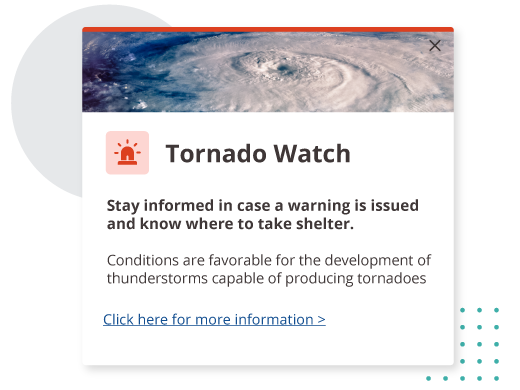
2. Crisis Management Team
The business continuity response is led by the Crisis Management Team (CMT). The purpose of the CMT is to:
- Enable existing or potential crises to be recognized promptly
- Ensure crises are well managed, providing the best possible outcomes for the organization and stakeholders
Crisis Management Team responsibilities include:
- Minimizing the risk and impact to the organization
- Providing information to decision-makers to make quick and sound decisions
- Ensuring a strategic overview is maintained during the crisis response and recovery
Team Roles and Responsibilities
Your crisis teams should comprise some or all of the following, depending on the crisis situation. It will be lead by a team leader, the Crisis Manager.
- Crisis Manager
- Crisis Coordinator
- Information Security/Business Continuity Lead
- Finance Lead
- Operations Lead
- Information Technology Lead
- Human Resources/Internal Communications Lead
- External Communications Lead
All members of the Crisis Management Team should keep a copy of the Business Continuity Plan at home. They must also know where to access a copy at work at short notice if required.
Team Structure
An example Crisis Management Team structure is shown below. Dependent on the specific crisis, the Crisis Manager will determine which roles are required.
3. External Communications
When a crisis event is declared, you will need to communicate with customers, suppliers, media and potentially the public.
These communications need to be timely and consistent as they present the official organization position at that time. They will be initiated and approved at CMT level but may be released through different people and processes.
Media Responses
The most effective way to manage the media is to funnel all enquiries to one source.
Ensure that all general email addresses are being monitored and media enquiries logged. Make sure that all frontline staff have been briefed for potential phone and in-person enquiries.
Example Media Statement
Due to [Situation], the following [Business Units or Sites] have experienced a disruption to normal business activities.
We are working to resolve the situation and expect services to resume in [Timeframe].
Until normal business activities are fully resumed, please [Further Instructions].
This message will next be updated by [Update Timeframe] at the latest.
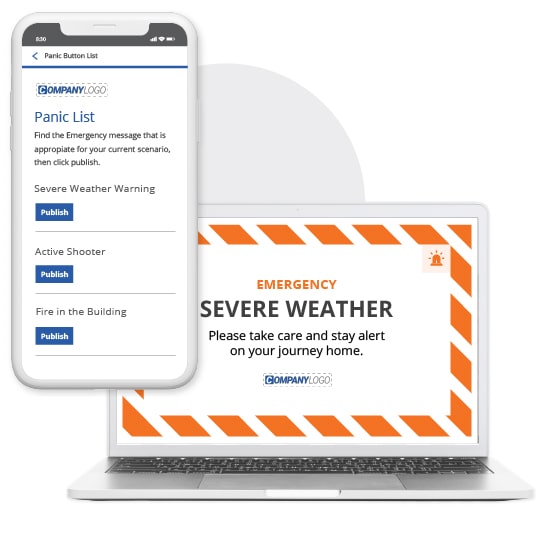
4. Internal Communications
When a crisis occurs, staff must also be informed immediately. Emergency communications alert employees to the threat, keep them informed as the status changes, and reassure employers of their safety.
Use the form below to download our full crisis communication plan template.
i. Staff Check
From: Head of People & Culture
What it is: Initial status check to account for all potentially affected staff members. Information to be collected includes:
- Where are they?
- Are they injured?
- Do they have any immediate family injuries/concerns?
- Have they got somewhere safe to stay?
- What is the best way to communicate with them?
- Do they need any immediate assistance from the organization?
- Can they travel to/from the office?
- Can they work remotely (have laptop/phone connectivity etc.)?
- Are they available for work?
When to send: To be initiated as soon as practicable after a crisis event – ideally within first 15-30 minutes.
Managers are to report responses, issues, concerns back to HR Rep on CMT. The HR Rep or CMT is to collate/hold overall staff condition list.
Channels: Emergency notification channels including Panic Button to immediately notify all staff and Registration Alert to collect responses from affected staff.
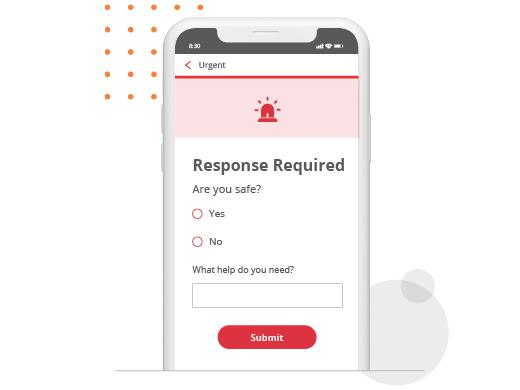
ii. Immediate Action Affected Staff Update
From: CMT
What it is: Get information to only those staff within an affected area. It should be used to get immediately actionable detail across only (e.g. "Do not return to Office", "Contact your manager within 1 hr." etc.).
When to send: As regularly as possible during the crisis, at least hourly.
Channels: Bulk SMS to affected staff.
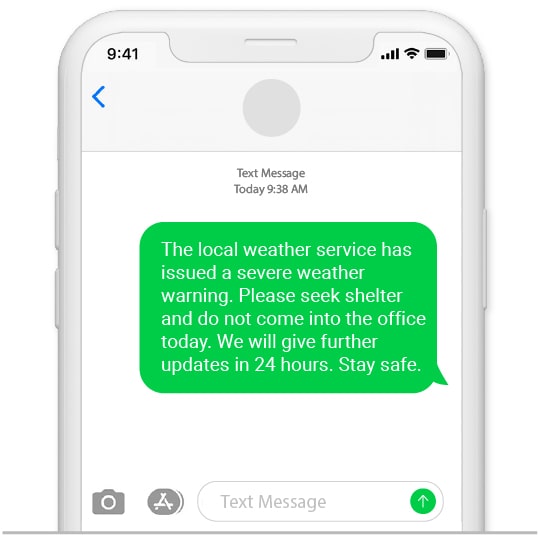
iii. All Staff Update
From: CMT / Head of Human Resources
What it is: Present longer, less-urgent information to all staff. The content may include:
- Summary of the crisis event to date
- Changes since last update
- Staff accountability update (may be used to ask for assistance in tracking down non-accounted for staff members)
- Message(s) from CEO/Senior Executives
- Forecast actions for the next 24 – 48 hours
- Any local instructions regarding work/access/reporting for affected staff
- Feedback from the wider community/public
- General guidance information (e.g. Government website details)
When to send: When practicable, ideally within first 30-60 minutes.
Channels: Organization-wide email, with Managers having additional responsibility to pass on information to staff without email access (e.g. by phone call).

iv. Technical Update
From: COO / Head of Operations
What it is: Provide information regarding the recovery or availability of services, including detail on what actions are being undertaken, forecast recovery times and workarounds.
These may cover anything from a single service (e.g. WAN network availability, to wider, overarching updates describing the status of all services.
When to send: Ad-hoc depending on situation.
Channels: Organization-wide email or digital newsletter.
Download Crisis Management Plan Template
Get your copy of the full Crisis Management Plan template by completing the form below.
